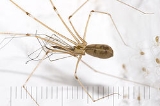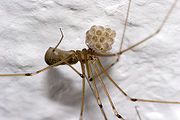
Pholcus phalangioides
Encyclopedia
The cellar spider or daddy longlegs (Pholcus phalangioides), also known as the skull spider due to its cephalothorax
looking like a human skull
, is a spider
of the family Pholcidae. Females have a body length of about 9 mm; males are slightly smaller. Its legs are about 5 or 6 times the length of its body (reaching up to 7 cm of leg span in females). Its habit of living on the ceilings of rooms, caves, garages or cellars gives rise to one of its common names. They are considered beneficial in some parts of the world because they kill and eat other spiders, including species that are venomous to humans such as hobo
and redback spiders.
Originally a species restricted to warmer parts of the west Palearctic
, through the help of humans this synanthrope
now occurs throughout a large part of the world. It is unable to survive in cold weather, and consequently it is restricted to (heated) houses in some parts of its range.
This is the only spider species described by the Swiss entomologist
Johann Kaspar Füssli
who first recorded it for science in 1775. Confusion often arises over its common name, because "daddy longlegs
" is also applied to two other unrelated arthropods: the harvestman and the crane fly
.
Pholcus phalangioides has the habit of shaking its web
violently when disturbed as a defence mechanism against predators. They can easily catch and eat other spiders (even those much larger than itself, such as Tegenaria duellica), mosquito
es and other insects, and woodlice. When food is scarce, they will prey on their own kind.
Because they originally came from the tropics
, these spiders do not appear to be influenced by seasonal changes and breed at any time of the year. The female holds the 20 to 30 eggs in her pedipalp
s. Spiderlings are transparent with short legs and change their skin about 5 or 6 times as they mature.
 An urban legend
An urban legend
states that Pholcidae are the most venomous spiders in the world, but this claim has been proven untrue. Recent research has shown that pholcid venom has a relatively weak effect on insects. In the MythBusters
episode "Daddy Long-Legs" it was shown that the spider's fangs (0.25 mm) could penetrate human skin (0.1 mm) but that only a very mild burning feeling was felt for a few seconds.
Cephalothorax
The cephalothorax is a tagma of various arthropods, comprising the head and the thorax fused together, as distinct from the abdomen behind. The word cephalothorax is derived from the Greek words for head and thorax...
looking like a human skull
Human skull
The human skull is a bony structure, skeleton, that is in the human head and which supports the structures of the face and forms a cavity for the brain.In humans, the adult skull is normally made up of 22 bones...
, is a spider
Spider
Spiders are air-breathing arthropods that have eight legs, and chelicerae with fangs that inject venom. They are the largest order of arachnids and rank seventh in total species diversity among all other groups of organisms...
of the family Pholcidae. Females have a body length of about 9 mm; males are slightly smaller. Its legs are about 5 or 6 times the length of its body (reaching up to 7 cm of leg span in females). Its habit of living on the ceilings of rooms, caves, garages or cellars gives rise to one of its common names. They are considered beneficial in some parts of the world because they kill and eat other spiders, including species that are venomous to humans such as hobo
Hobo spider
The hobo spider is a member of the genus of spiders known colloquially as funnel web spiders, but not to be confused with the Australian funnel-web spider. It is one of a small number of spiders in North America whose bites are generally considered to be medically significant...
and redback spiders.
Originally a species restricted to warmer parts of the west Palearctic
Palearctic
The Palearctic or Palaearctic is one of the eight ecozones dividing the Earth's surface.Physically, the Palearctic is the largest ecozone...
, through the help of humans this synanthrope
Synanthrope
Synanthropes is a term applied to species of wild animals and plants of various kinds that live near, and benefit from, an association with humans and the somewhat artificial habitats that humans create around them . Those habitats include houses, gardens, farms, roadsides, garbage dumps, and so on...
now occurs throughout a large part of the world. It is unable to survive in cold weather, and consequently it is restricted to (heated) houses in some parts of its range.
This is the only spider species described by the Swiss entomologist
Entomology
Entomology is the scientific study of insects, a branch of arthropodology...
Johann Kaspar Füssli
Johann Kaspar Füssli
Johann Kaspar Füssli, also written Johann Caspar Fuesslins, was a Swiss painter, entomologist and publisher....
who first recorded it for science in 1775. Confusion often arises over its common name, because "daddy longlegs
Daddy longlegs
-Biology:* Opiliones, an order of arachnids also commonly known as harvestmen* Crane fly, winged insects belonging to the family Tipulidae* Pholcidae, a family of spiders also commonly known as cellar spiders...
" is also applied to two other unrelated arthropods: the harvestman and the crane fly
Crane fly
A crane fly is an insect in the family Tipulidae. Adults are very slender, long-legged flies that may vary in length from though tropical species may exceed to ....
.
Pholcus phalangioides has the habit of shaking its web
Spider web
A spider web, spiderweb, spider's web or cobweb is a device built by a spider out of proteinaceous spider silk extruded from its spinnerets....
violently when disturbed as a defence mechanism against predators. They can easily catch and eat other spiders (even those much larger than itself, such as Tegenaria duellica), mosquito
Mosquito
Mosquitoes are members of a family of nematocerid flies: the Culicidae . The word Mosquito is from the Spanish and Portuguese for little fly...
es and other insects, and woodlice. When food is scarce, they will prey on their own kind.
Because they originally came from the tropics
Tropics
The tropics is a region of the Earth surrounding the Equator. It is limited in latitude by the Tropic of Cancer in the northern hemisphere at approximately N and the Tropic of Capricorn in the southern hemisphere at S; these latitudes correspond to the axial tilt of the Earth...
, these spiders do not appear to be influenced by seasonal changes and breed at any time of the year. The female holds the 20 to 30 eggs in her pedipalp
Pedipalp
Pedipalps , are the second pair of appendages of the prosoma in the subphylum Chelicerata. They are traditionally thought to be homologous with mandibles in Crustacea and insects, although more recent studies Pedipalps (commonly shortened to palps or palpi), are the second pair of appendages of the...
s. Spiderlings are transparent with short legs and change their skin about 5 or 6 times as they mature.
Venom

Urban legend
An urban legend, urban myth, urban tale, or contemporary legend, is a form of modern folklore consisting of stories that may or may not have been believed by their tellers to be true...
states that Pholcidae are the most venomous spiders in the world, but this claim has been proven untrue. Recent research has shown that pholcid venom has a relatively weak effect on insects. In the MythBusters
MythBusters
MythBusters is a science entertainment TV program created and produced by Beyond Television Productions for the Discovery Channel. The series is screened by numerous international broadcasters, including Discovery Channel Australia, Discovery Channel Latin America, Discovery Channel Canada, Quest...
episode "Daddy Long-Legs" it was shown that the spider's fangs (0.25 mm) could penetrate human skin (0.1 mm) but that only a very mild burning feeling was felt for a few seconds.
External links
- Information on the Long Bodied Cellar Spider - often called "daddy long legs"
- Description and pictures
- Long description and pictures

